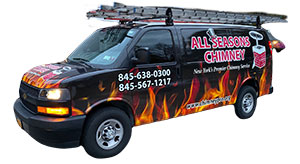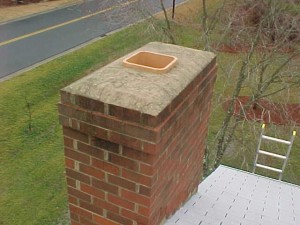From our years in experience of working in the chimney industry, All Seasons Chimney understands the problems that water can cause to a fireplace and chimney system. In fact, the Chimney Safety Institute of America (CSIA) named water as the biggest enemy of a masonry chimney. Except for stone, all masonry chimney construction materials suffer from accelerated deterioration when exposed to water for an extended period of time. Preventing water penetration of chimneys is one of our most important duties as chimney experts, and we know how to best keep the water out of your chimney. One of the most simple ways to stop water from entering your chimney in the first place is the installation of a chimney crown. We would like to tell you more about chimney crowns and how they can protect the masonry materials of your chimney.
What exactly is a chimney crown?
Also known as a chimney wash, a chimney crown is the top part of a masonry chimney. Constructed from mortar, the chimney crown covers and seals the top of a chimney from the flue liner to the chimney edge.
Why do I need a chimney crown installed on the top of my chimney?
Without a chimney crown, your chimney is open to rainwater and water from melted snow. This water will penetrate the bricks and mortar of your chimney. In the winter, this water repeatedly freezes and thaws, and this process causes problems. When water freezes, it expands as much as 10 percent. This can create cracks in the bricks and mortar, which worsen each time this water freezes. Even tiny amounts of water can cause this type of spalling damage. Eventually, if left unrepaired, the bricks and mortar can become so deteriorated that your chimney is no longer structurally sound.
If a chimney crown is made from mortar, how is it protected from spalling damage?
Since the chimney crown sits on the top of your chimney exposed to all of the elements of weather, it should be sealed with a durable waterproofing treatment to protect it from water penetration. A customized chimney crown from All Seasons Chimney is also constructed from a Portland cement-based mixture that is designed for years of weather abuse.
How can I tell if my chimney crown is properly constructed and installed?
A properly built chimney crown should have a slope to best protect your chimney from water damage. Your chimney crown should provide a downward slope to direct water from the flue to the edge of the crown. There should also be an overhanging drip edge to direct water from the crown away from the chimney to help prevent any erosion of the bricks and mortar in the vertical surfaces of the chimney. This overhang should project beyond all sides of the chimney by a minimum of two inches for best protection from water damage.
In need of a chimney crown? Contact All Seasons Chimney to schedule a custom installation of a crown for your chimney.



